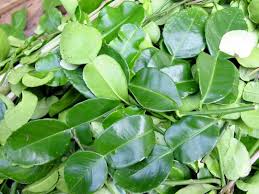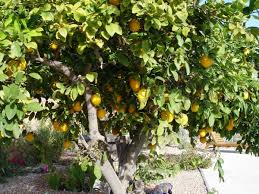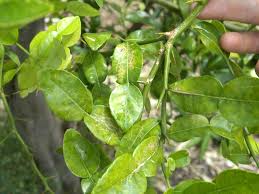Kaffir lime trees are native to Southeast Asia. The botanical name for the Kaffir lime tree is Citrus hystrix. However, the Kaffir lime tree goes by many other names in different areas.
The word Kaffir has a negative connotation. Some people would rather call this very versatile citrus fruit tree other names. In South Africa, the Kaffir lime tree is called the Thai lime; in Cambodia and most Southeast Asia, it’s known as Makrut or Makrud. Some people call it the Mauritius papeda.
Regardless of the negativity attached to the name Kaffir, Kaffir is still the most popular name for the Citrus hystrix. Call it what you may, but the Kaffir lime is quite essential in Southeastern Asia kitchens, so much so that almost every home has a Kaffir lime tree in the backyard.
History of Kaffir Limes
Kaffir limes are citrus fruit trees, and as such, their history is tied to the history and origin of citrus fruit tree trees. Generally, there is much confusion regarding the classification and origin of the genus Citrus. There are so many gaps in the knowledge of a heredity and evolutionary path of citrus fruit trees.
The Kaffir lime is primarily native to Southeast Asia but has widely adapted to tropical areas. Different theories explain how the Kaffir lime from Southeast Asia was introduced to the rest of the tropics. Still, none of them is backed by factual findings. Therefore the original distribution of the Citrus hystrix is uncertain and unknown.
Uses of Kaffir lime tree

The hourglass-shaped double leafed Kaffir lime leaves are the most commonly used part of the Kaffir lime tree. You can use the leaves fresh from the tree or after they have been dried and even when they have been frozen.
Listed below are the most common uses of the Kaffir lime tree.
1. Cuisines
The Kaffir leaves are used in several Southeast Asian cuisines, including;
- Thai tom yum.
- The Cambodian base, a paste is known as Krueng.
- Vietnamese to spice fish and chicken and to reduce the pungent odor when steaming snails
- Indonesian Soto Ayam
Use of the other Kaffir lime tree parts in cuisines
- You can also use the Kaffir lime leaves in stews, soups, lime cards, and chutneys because of their distinctive citrusy scent.
- The Kaffir lime fruit zest can also be used to add the refreshing lime flavor in dishes.
- Kaffir lime fruits are often candied in Cambodia.
2. Cleansing
Kaffir lime fruits are not palatable, but their juice is key in making organic cleaning reagents. Their juice smells not only heavenly and fresh but also has antiseptic qualities.
The juice of Kaffir lime fruits is an ingredient in an array of hygiene products like body washes and shampoos.
Some people make their own organic detergents using Kaffir lime juice. The procedure of making organic detergent using Kaffir lime juice is so simple; follow the steps written below to make your own.
- Peel that limes and save the zest for you cooking. You don’t have to worry about how you will save the latest it can be safely frozen and kept for later.
- Squeeze the juice out of Kaffir limes and keep the seeds for planting. You are interested in growing the Kaffir lime tree from the seed.
- Put the juice into an ice tray or whatever freezing tray you have put and freeze overnight.
- Dilute the frozen juice bars into a solution of vinegar and water voilá. You have yourself an organic heavenly-scented detergent.
3. Cocktails and mocktails

Show me someone who doesn’t love a good cocktail, and I’ll show you a liar. Like seriously, who doesn’t like the sweet, tangy, burning, thirst-quenching drink on the rocks?
Some cocktails and mocktails wouldn’t be the same without nature’s gift of the Kaffir lime. Here is a list of the ones that I think you’ll enjoy the most.
- Creamy coconut and lime Margarita
- Lemongrass, Kaffir lime, and ginger mojito
- Kaffir lime matcha gimlet
- The Costa Blanca
- Kaffir lime colada
- Kaffir lime Mimosa
You need to enjoy the spellbinding effect of a Kaffir Lime cocktail or mocktail, and thank me later.
How to grow Kaffir lime tree
The Kaffir lime tree can be propagated from the seed, by grafting or from stem cuttings. Many different factors come into play in deciding which method of growing a gardener uses, including the purpose of growing and demand for the Kaffir lime.
If you are growing Kaffir trees as a hobby, you can choose any propagation method you like. After all, it is for your amusement. If, however you a growing the kaffir lime tree economically, you might want to go see the graph thing because it takes a shorter time I’m can meet the demand
Naturally, the Kaffir lime tree should be grown from the seed. Modern farmers have still adopted grafting because of the tree’s commercialization and the demand, especially the tree leaves.
The most popular and favored method is grafting, followed by seed propagation and stem cutting last. The major reasons why a farmer may choose grafting overseed include the following.
Reasons why grafted Kaffir lime trees are more prevalent than seed-grown or stem cutting grown trees.
1. Grafted lime trees take a shorter time to fruit.
Normally a kaffir lime tree should take anywhere between 4-10 to fruit if it ever fruits. On the other hand, a grafted kaffir lime tree takes anywhere between 2_3 years to fruit.
This doesn’t mean that grafting makes a tree grow faster. Still, the grafted Scion has the same genetic maturity as the parent plant it was taken from. If the source plant was mature, which is most likely the case, the grafted kaffir lime tree has a head start, so to say, and should fruit sooner or later.
On the other hand, a Kaffir lime grown from the seed needs to fast grow through all the stages of growth to maturity before it can start to blossom and, consequently, fruit. In a way, grafting gives a farmer a chance to skip the lime’s waiting to grow to maturity by simply grafting a Scion from a mature Kaffir lime to a hardy rootstock.
2. Grafting makes it possible to grow Kaffir lime trees in soils it normally wouldn’t.
The rootstock that is commonly used in grafting is usually of hardy and resistant varieties of citrus. This means that a heavy or clay soil sensitive Kaffir lime Scion coupled with a clay soil tolerant rootstock will grow in clayey soils.
Also, some rootstocks are resistant to pests and diseases. Grafting them with a weak but desirable variety like the Kaffir lime confers resistance to the desirable variety. It then makes the Kaffir lime tree able to withstand harsh conditions, pest and disease infestation it couldn’t previously withstand.
3. The Gardener can dwarf a normally tall tree by grafting.
A garden can intentionally dwarf an ideally 20 ft plus to even less than 8 ft by grafting it onto dwarf rootstock. Conferring resistance to that Kaffir lime tree is not the only advantage grafting.
Dwarfing trees makes it easier to harvest, prune, spray, and generally take care of the tree. This would otherwise be tedious with a full tree size Kaffir lime.
The disadvantage of grafting.
Grafting has one downside: grafted Kaffir lime trees don’t live as long as seed-grown trees. This is because, as mentioned, the grafted Scion has the maturity of the parent plant from which it was taken; therefore, a grafted plant doesn’t start its life post grafting at zero.
Just as in cloning, a grafted tree has the age and maturity of the parent’s plant cells from which it was propagated. This means that if the parents from where the Scion was taken before grafting was four years your grafted plant, he’s already four years old evening on the first day of planting.
As a result, grafted trees mature and reach old age faster than seeded plants.
It is important for you to note that Kaffir lime trees can be grown from seed. Stem cutting and grafting. All methods mentioned above are viable except when the variety you are propagating is monoembryonic. In that case, the seed propagation will be futile.
Kaffir lime tree growing zone
The Kaffir lime tree is hardy to USDA zone is zone 9 to 10. This is from moderately to sensitive to cold. Lime trees are extremely sensitive to cold.
The general conditions Kaffir lime trees require for growth are;
- Full sun and at least 6 hours of sunlight.
- Temperatures of no lower than 10°C or 50°F.
- Good drainage
How to graft Kaffir lime tree

The first step in grafting is to acquire a suitable rootstock. The most commonly used good stocks for kaffir lime tree grafting are;
- Trifoliate Orange
- Cleopatra Mandarin
- Sour Orange
- Rough lemon
Steps in grafting a Kaffir lime tree.
- Prepare the rootstock
Cut the main stem of the rootstock at 45-degree angles. The cut should be at least 2 inches long and several inches above this soil.
2. Acquire and prepare the Scion (the stem of Kaffir lime tree)
Select a couple lines team which should be about 1.5 to 2 inches long and preferably under 1 year and with buds on it.
Cut the Kaffir lime tree stem the same kind of cut as you did in the rootstock. That is a 45-degree slanting cut.
3. Join the rootstock and Scion
After preparing the stem of a kaffir lime tree, match the stem’s cut with that rootstock.
4. Tape with grafting tape.
After touching the rootstock to the Scion, secure with drafting tape tightly, you could also seal with grafting wax if you like, but that is unnecessary.
While the grafting is still bonding and healing, make sure that you protect it from excessive moisture and direct sun.
Otherwise, you will know that you have succeeded when you see leaves starting to grow on the Kaffir lime line cutting after the first couple of weeks.
How to grow Kaffir lime tree from cutting
Growing kaffir lime trees from cuttings is an easy process but requires effort. Here is the step by step guide on how you can grow kaffir lime trees from cuttings
1. Prepare the rooting medium.
To get in your roots from a stem cutting, you must use moist sand or potting soil. The medium should be moist, not soggy. Then proceed to create a hole for the twig.
2. Prepare the cutting.
You must begin by choosing a stem tip from the parent plant. Ensure that the stem tip is approximately 4 inches long, has no flowers or fruit, and remove all the upper two or three leaves.
You can now plant the cut end of a stem tip into the rooting medium by placing it into the hole you previously made.
3. Care for the cutting
The key to successfully taking care of cutting to make it root is to keep the rooting medium humid and moist all the time.
Remember that the cutting has no roots and, as such, can easily dry out. Apart from watering the rooting medium, you should ensure that you place the rooting set up in the shade and keep it away from direct sunshine.
4. Transplanting
On average, it takes anywhere from 6-8 weeks for a cutting to develop roots and be ready to transplant.
Pro tip: you can tell that a cutting is ready to transplant when you give it a gentle tug, and you feel that the plant is being held in the soil. Well developed roots can hold a plant in the soil, so if you felt that the plant was firm, then that’s a sign that it is ready to be transplanted.
Gradually harden the plant by placing it in the sun for a few hours and increasing the duration as the days pass by until the plant can stay all day outdoors without drying out. If you feel that an implant can finally stay all day outdoors, then it’s safe to plant it in the garden.
At this point, you can now get your transplanting tools ready and create a hole in the place where you’d like to transplant.
Lift the cutting with the growing medium and plant cutting with the medium in the hole you’ve created. Water and check on the transplanted plant over a month to ensure adapting to the new environment.
How to grow Kaffir lime tree from the seed
Growing a Kaffir lime tree from the seed is a thrilling process because, like a wrapped gift, you never know what you’ll get. But the whole process is worth it in the end.
If you want to grow a kaffir lime tree from the seed, follow the procedure below.
1. Extract the seeds from a ripe Kaffir lime fruit.
Cut a ripe Kaffir lime fruit into two biased halves. Don’t cut down the middle.so that you do not damage the seeds.
Squeeze out the juice, and the seeds will be released with the juice. Alternatively, you can buy the seeds from your local nursery.
2. Clean the seeds
Wash the seeds to ensure that they are clean and free from any microbes.
3. Dry the seeds.
You can use the paper towel method. This means that you simply lay the seeds in a paper towel and tap them dry using another paper towel.
4. Prepare the germinating bag.
Disinfect a ziplock bag and label it with the date on which you will germinate the seeds. Dump a paper towel, place the seeds in it, and put in the disinfected ziplock bag.
5. Germinate the seeds
Keep the set up in a warm dark place and wait for up to a week. It sucks about 5-6 days for kaffir lime seed to germinate.
6. Plant the seedlings

Once the seedlings have germinated, plant the seedlings in a seedbed and water generously for the next couple of months.
7. Transplant
After two to three months in the seedbed, wait for the weather outside to become warm and then transplant to a growing pot or garden.
When growing Kaffir lime trees from seeds, please note that it will take longer than grafted trees for the tree to mature, so you need to be patient when you do not see fruits or blossoms straightaway. It is normal.
Kaffir lime tree care
Care for kaffir lime trees is the basic lime tree care. You need to protect the tree from frost, sunburn, poor drainage, pests, diseases, fertilizer, water, and prune.
Kaffir lime trees have the same cultural requirements as all citrus trees. The Thai limes don’t tolerate heavy clay soils or those high in salt.
It is better to plant in early spring, so they have time to become established before the heat of summer arrives. Read on for an in-depth discussion on care for Kaffir lime trees.
1. Protection from frost
Kaffir lime trees are sensitive to cold, so if you live in a cold area, remember to take your potted kaffir lime trees in.
However, if you planted in the ground and you cannot carry them in, insulate them. Whatever it takes, you need to keep kaffir lime trees at temperatures above 10 degrees Celsius.
2. Protection from sunburn
If the tree sustains too much heat damage, it could die. It is important to protect bare tree barks from sunburn by whitewashing the barks of the Kaffir Lime tree barks with organic whitewash
While too much frost is bad for you Kaffir lime trees, too much heat as well could damage the kaffir lime trees.
Exposing bare bark to the sun can cause sunburn to a Kaffir lime tree. When Kaffir lime trees get sunburnt, it is an irreversible change depending on the degree of burn that the tree sustained.
3. Soil drainage
Like all lime trees, kaffir lime trees can withstand stagnant water; it is important, therefore, that where you plant kaffir lime trees has good drainage.
If it is impossible to seal good drainage, it would be wise to create a mount and plant the line in the raised ground to flow away.
Too much stagnant water can cause root rot to a Kaffir lime tree.
4. Pest and disease control
Kaffir lime trees are considered hardy and largely unbothered by pests and diseases. However, one of the problems almost every Kaffir lime farmer will face is scale infestation. Scale insects can be white (often called snow scale) brown, black, or grey in color.
There are two types of scale insects;
- Soft scale
- Armoured Scale
The scale is problematic because it feeds on the sap of the Kaffir lime trees. You may not even notice that you have a scale infestation earlier on until you experience;
- Yellowing of leaves
- Stunted growth
- Honeydew
- Blackening of leaves
- Death of the tree
Ladybugs eat scale, so do not fight away any ladybugs that you see on your lime tree. However, you can’t rely on ladybugs to fight off all your scale pests.
Here is a list of ways to get rid of the scale on your Kaffir lime tree.
- Try neem seed oil. It is always advisable to try neem seed oil for infections on citrus fruits before any harsh chemicals. Neem oil suffocates the pests and kills them.
However, it is important to remember to wash the plant after applying neem oil. If it stays too long on the leaf surface, it could become toxic.
- Prune away diseased branches and leaves.
- Rub affected parts with diluted rubbing alcohol.
- If all else fails, wrap a plastic bag from the stem downward and blast insecticide on the tree. You will kill some leaves in the process, but the good news is that you will have killed the scale.
Besides, if the scale infestation had gone one, all the leaves were going to fall off anyway. After spraying insecticide, you need to show the tree some TLC, water and fertilize regularly. After a few months, you should have new growth.
All other Kaffir lime tree infections can be fought the same way as the notorious scale. Always start with neem seed oil, before any other harsh and artificial chemicals.
5. Fertilizer application
Kaffir limes as all limes are heavy feeders and they shall deplete all the nutrients in the soil they are growing in, I’m no time. It is, therefore, imperative that the Gardener frequently fertilizes.
You can fertilize with organic compost or nitrogen-rich sure release fertilizer. If you use organic compost, you may have to fertilize more because it depletes faster than the slow-release fertilizer.
Remember to follow the manufacturer’s instructions on how much fertilizer to use as per plant size. You can use your observation. If your plant is healthy and has no other issues like pests, diseases, or poor drainage, but the leaves are turning yellow, you noticed reduced vigor and stunted growth, then fertilize.
The like could be malnourished.
6. Watering
Kaffir limes like water, but there is a limit beyond which any additional watering will kill the lime tree.
As a Kaffir lime farmer, you need to water just enough to keep the soil moist but not soggy. If you can’t strike a balance, you can plant your Kaffir lime tree in a special container with a saucer at the bottom where you just fill the saucer and no capillary action the soil waters required.
It is also important to remember to water slightly more when the tree is fruiting or blossoming.
Kaffir lime tree problems

Kaffir lime trees are considered resistant but are often disturbed by the following problems;
- Frost. This you can prevent by taking the plants in during winter. There isn’t much I can do after your tree has been affected by for. You have to wait for the spring to come, then you prune off the frost-damaged twigs and branches.
- Sunburn can prevent sunburn by avoiding over prune, which exposes the delicate tree bark and whitewashing in the exposed tree bark.
Depending on the extent or degree of the burn sustained by the plant, you might have to prune or lose the whole plant entirely.
- As mentioned above, mites and all other pests can be caught the same way scales are.
- Gummosis. With gummosis, you might have to keep removing any diseased part until, hopefully, all the darkened bark is no more.
Where to find Kaffir lime tree to grow
You can find Kaffir lime trees to grow on eBay, Amazon, Alibaba, and practically all online shopping sites.
The safest place to get Kaffir lime trees to grow is as seeds, young grafted plants, or stem cutting from your local nursery.
Final thoughts
The Kaffir lime tree may, according to many, have a despised and even unfortunate name. Still, there is nothing unfortunate about the Kaffir lime.
